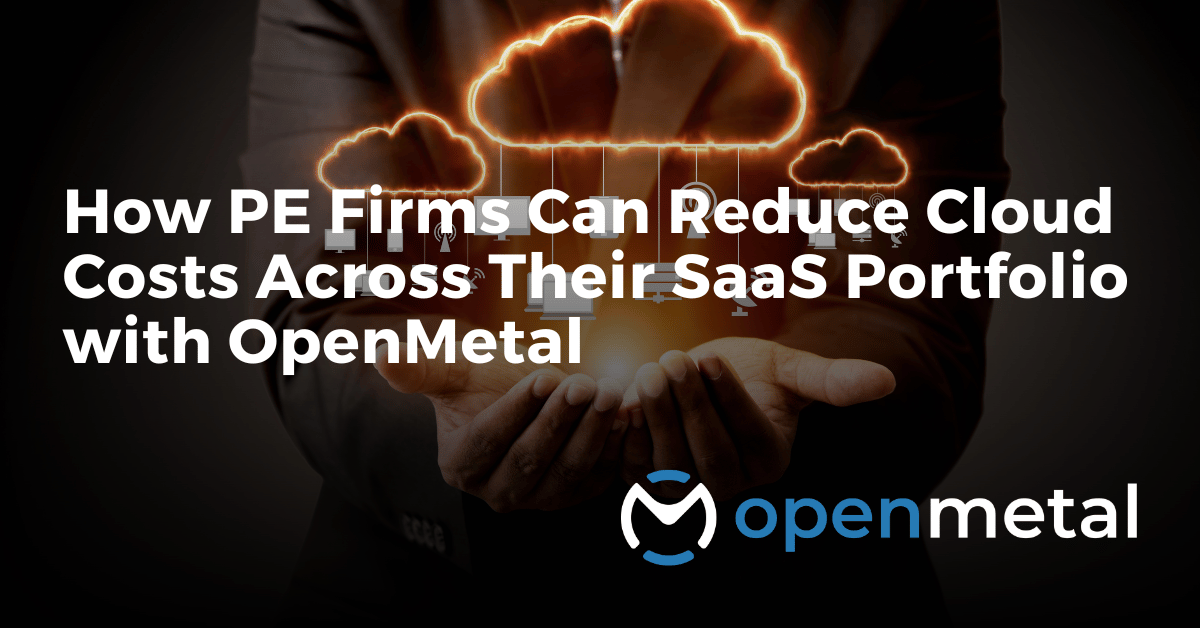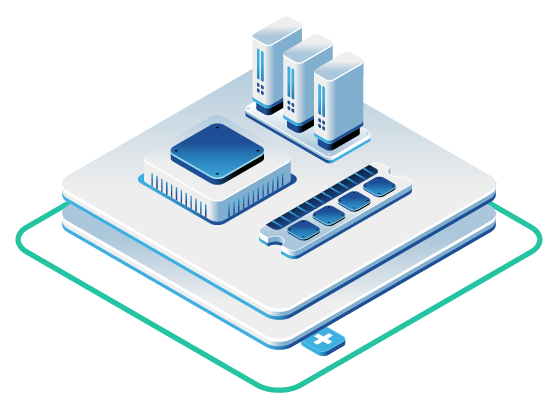
Managing cloud infrastructure costs across a portfolio of SaaS companies presents one of the most significant operational challenges facing private equity firms today. While public cloud platforms enable rapid scaling for your portfolio companies during initial growth phases, the financial reality becomes stark as these businesses mature: infrastructure costs can reach 50% of total cost of revenue, creating unsustainable margin pressure that directly impacts valuations and exit multiples.
You’re not alone in this challenge. Research from Bain & Company reveals that 84% of on-premise workloads are overprovisioned, and when companies migrate to public cloud without proper planning, they often transfer these inefficiencies directly to their new environment1. For PE firms evaluating portfolio optimization opportunities, cloud cost reduction represents one of the most actionable value creation levers available today.
The Hidden Costs Destroying SaaS Margins
Your portfolio companies likely started with public cloud for compelling reasons: instant scalability, zero upfront hardware costs, and rapid time-to-market. However, as these businesses mature and workloads stabilize, several cost drivers begin compounding in ways that weren’t apparent during early growth phases.
Usage-based pricing creates the first major challenge. Unlike traditional infrastructure costs that remain predictable, public cloud spending fluctuates with customer activity, seasonal variations, and feature usage patterns. This unpredictability makes financial planning difficult and forces conservative capacity planning that often results in overprovisioning.
Multi-tenant environments introduce performance variability that your teams compensate for by allocating additional resources. When applications share infrastructure with unknown neighbors, ensuring consistent performance requires building in safety margins that translate directly to higher costs.
Data egress fees represent another cost category that scales unexpectedly. As your SaaS companies grow their customer bases and expand internationally, these charges compound rapidly. What seemed negligible during early customer acquisition phases can become substantial budget line items as companies reach enterprise scale.
The “instance type trap” forces your technical teams into predetermined configurations offered by hyperscalers rather than infrastructure sized for actual application requirements. This mismatch between available options and real workload needs frequently results in paying for resources that remain underutilized.
Why Traditional Cost Optimization Falls Short
Standard cloud optimization approaches—right-sizing instances, implementing auto-scaling, negotiating reserved capacity—provide incremental improvements but fail to address the fundamental structural issues driving costs higher.
Companies that rightsize their workloads can cut costs by as much as 30% to 60% when they migrate them to the public cloud1, but this optimization requires continuous monitoring and adjustment as workloads evolve. For PE firms managing multiple portfolio companies, this approach demands specialized expertise and ongoing operational overhead across every investment.
More importantly, these optimizations still leave your companies subject to the unpredictable cost structure and shared resource limitations inherent in public cloud architectures. You may reduce waste, but you haven’t eliminated the fundamental drivers of cost unpredictability that make financial planning challenging.
The OpenMetal Solution: Portfolio-Wide Cost Control
Private equity-backed SaaS companies often face a tough challenge: reduce infrastructure costs without disrupting performance or slowing growth. That’s easier said than done when teams are spread across different platforms or relying on public cloud providers where usage-based pricing and multi-tenant environments make it difficult to predict spend or optimize configurations.
OpenMetal gives portfolio companies the ability to launch dedicated private cloud environments that behave like public cloud — but with fully isolated infrastructure, clear costs, and no long-term commitments. These environments run on dedicated hardware and can be live in less than 45 minutes. Because you’re not sharing resources with other tenants, you’re not affected by noisy neighbors or the limitations of someone else’s architecture. Everything is yours so your team has complete control over how they deploy, scale, and budget.
One of the biggest advantages for PE firms is the ability to bring consistency to infrastructure governance across the portfolio. Instead of each company managing cloud costs differently — some overprovisioning out of caution, others stuck in complex hyperscaler pricing models — OpenMetal offers a way to standardize costs, visibility, and performance tracking. You get a repeatable model that helps your portfolio companies align their infrastructure to growth and margin goals, without needing to reinvent the wheel each time.
Predictable Cost Structure
OpenMetal pricing is flat-rate and easy to understand. There are no surprise egress fees or vague licensing costs, and teams aren’t locked into instance types that don’t match their workloads. If one SaaS company is in growth mode and another is stabilizing, you can provision environments that match their stage — from a Medium V4 with Ceph for smaller, more agile teams to Large or XL configurations for companies running heavier workloads.
You’re not paying for more than you need, and you’re not boxed into less than you can use. For PE firms looking to reduce cloud spend across a portfolio and increase EBITDA, this flexibility would be worth it.
The Financial Impact: Rule of 40 and Valuation Multiples
Understanding how infrastructure costs impact portfolio valuations requires examining the metrics that matter most to institutional investors. The Rule of 40 helps SaaS companies balance growth and profitability. It states that the sum of a SaaS company’s revenue growth and profit margin should be equal to or greater than 40%, which is the threshold at which the company is considered financially healthy, sustainable, and attractive to investors2.
When cloud costs consume 40-50% of revenue, achieving positive EBITDA margins becomes mathematically challenging, particularly for companies prioritizing growth. This creates a direct conflict between the growth rates that drive valuations and the profitability metrics that institutional investors require for exit multiples.
High-growth software companies often trade at 24-25x gross profit multiples, meaning every dollar of gross profit saved through infrastructure optimization translates to $24-25 in market capitalization gains1. For a portfolio company spending $2 million annually on cloud infrastructure, a 40% cost reduction through private cloud migration could generate $800,000 in annual savings, potentially creating $20 million in additional enterprise value.
Infrastructure Sizing for Different Portfolio Scenarios
Your portfolio companies likely represent different stages of SaaS maturity, from early-stage platforms serving thousands of users to enterprise-focused solutions handling millions of transactions monthly. OpenMetal’s infrastructure configurations align with these varying requirements without forcing companies into predetermined molds.
For smaller SaaS companies with moderate workloads—perhaps running web applications with a few thousand users or testing new features—a Medium V4 Private Cloud with an added Ceph storage node provides sufficient control and performance. This configuration offers enough resources to handle development, staging, and production environments without the overprovisioning common in public cloud setups.
SaaS platforms experiencing steady customer activity, handling increased data volumes, or scaling features across teams typically find XL V4 or Large V4 configurations the best fit. These provide additional storage and network flexibility suited to production environments with consistent load patterns. The predictable performance characteristics help maintain service level agreements with enterprise customers.
For compute-intensive SaaS workloads—such as real-time data processing, ETL pipelines, or encryption-heavy operations—bare metal servers with attached Ceph clusters eliminate shared VM overhead. These configurations work particularly well for platforms prioritizing performance isolation and predictability, common requirements for enterprise SaaS offerings.
Implementing Infrastructure Standardization Across Your Portfolio
The most successful PE firms develop repeatable processes for evaluating and optimizing infrastructure across their portfolio companies. Rather than treating each investment as a unique technical challenge, you can implement consistent frameworks that identify optimization opportunities and measure improvement over time.
Start by establishing infrastructure spend as a key performance indicator across your portfolio. Companies approaching $1 million in annual cloud spend should begin evaluating private cloud alternatives, as this threshold often represents the point where optimization efforts justify transition costs. Track this metric alongside traditional SaaS metrics like customer acquisition cost and lifetime value to understand how infrastructure efficiency impacts overall unit economics.
Develop standardized assessment criteria for evaluating which portfolio companies benefit most from infrastructure migration. Applications with predictable resource requirements, consistent traffic patterns, and high current cloud costs typically deliver the best results from private cloud adoption. Data-intensive applications often see the largest cost savings due to elimination of egress charges.
Create consistent migration playbooks that can be deployed across multiple portfolio companies. Rather than rebuilding migration strategies for each investment, develop templates that account for common SaaS architecture patterns and deployment requirements. This approach reduces both the time and cost associated with infrastructure optimization initiatives.
Risk Mitigation and Performance Validation
One concern often raised by portfolio company management teams involves potential performance impacts from infrastructure migration. OpenMetal’s hosted private cloud addresses these concerns through comprehensive testing capabilities and gradual migration approaches.
Performance testing validates that applications will meet SLA requirements before production migration. OpenMetal’s infrastructure allows for comprehensive testing environments that mirror production workloads, reducing the risk of service disruption during transition.
The migration process itself can be gradual. Rather than moving all workloads simultaneously, successful transitions often begin with development and staging environments, allowing teams to build familiarity with the new platform before transitioning customer-facing systems. This phased approach minimizes business risk while demonstrating cost savings and performance improvements.
Monitoring and alerting capabilities ensure that performance metrics remain within acceptable ranges throughout the migration process. Teams can validate that response times, throughput, and availability metrics meet or exceed previous benchmarks before proceeding with additional workload migrations.
Value Creation Through Operational Excellence
Beyond direct cost savings, infrastructure standardization creates additional value through improved operational consistency across your portfolio. When multiple companies use similar infrastructure platforms and management processes, knowledge transfer between investments becomes possible, reducing the operational overhead required to maintain technical excellence.
Technical teams across your portfolio can share best practices, troubleshooting expertise, and architectural patterns when they’re working with consistent infrastructure platforms. This knowledge sharing accelerates problem resolution and reduces the specialized expertise required at each individual company.
Vendor relationship management becomes more efficient when multiple portfolio companies use the same infrastructure provider. Consolidated purchasing power can improve pricing terms, and shared technical relationships provide better support responsiveness across your entire portfolio.
Due diligence processes for future investments can incorporate infrastructure cost assessment as a standard evaluation criterion. Understanding potential infrastructure optimization opportunities during the investment evaluation process allows you to factor these savings into valuation models and post-acquisition value creation plans.
Getting Started: Assessment and Implementation
For PE firms ready to evaluate infrastructure optimization across their portfolio, the process begins with a comprehensive assessment of current cloud spending and identification of the best candidates for migration.
Financial modeling should account for both direct cost savings and indirect benefits like improved performance and reduced operational complexity. The most accurate TCO comparisons include staff time, support costs, and the value of improved predictability in financial planning.
Workload analysis helps identify the best candidates for migration. Applications with steady resource requirements, predictable traffic patterns, and high current cloud costs typically deliver the best results from private cloud migration. Performance testing validates that applications will meet SLA requirements in the new environment before production migration.
For PE firms and SaaS leaders looking to control infrastructure costs while maintaining growth trajectories, the economic case for hosted private cloud becomes compelling at scale. OpenMetal’s hosted private cloud platform eliminates the complexity of hardware management while delivering the cost predictability and performance control that growing SaaS companies need.
Ready to evaluate how private cloud can optimize your portfolio’s infrastructure costs? OpenMetal provides the infrastructure foundation that helps PE firms achieve both cost control and performance consistency across their SaaS investments. Learn more.
[1]Bain & Company. “Rightsizing Your Way to the Cloud.”
[2] Drivetrain.ai. “What Is the Rule Of 40 for SaaS Companies.”
Read More on the OpenMetal Blog


































